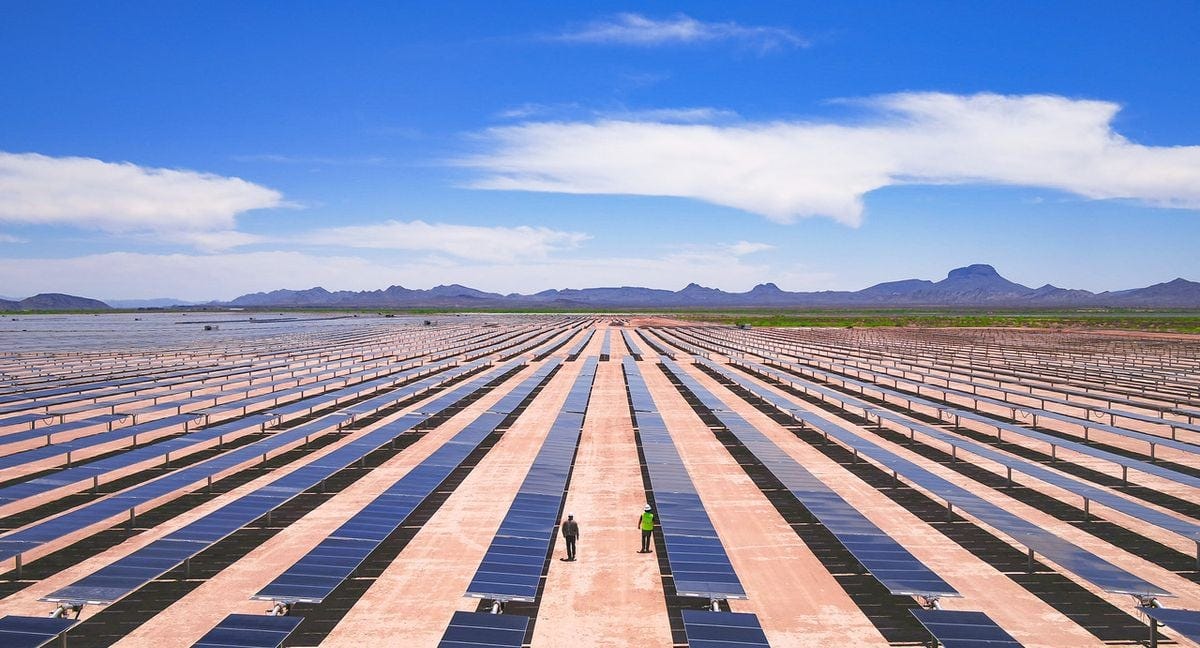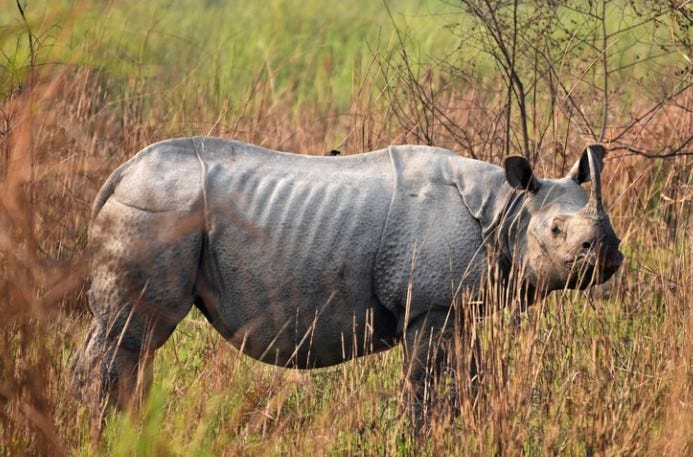The Weekly Anthropocene, January 25 2023
Dispatches Against Despair from the Wild, Weird World of Humanity and its Biosphere
Wildlife
In 2022, not a single Indian rhinoceros (Rhinoceros unicornis1) was killed by poachers in India’s Kaziranga National Park, a key stronghold for the species. This was the first time since 1977 that an entire year passed with zero rhino poaching in Kaziranga! And that’s really disproportionately good for the entire species, as Kaziranga is home to over 2,200 rhinos, more than 60% of the entire wild population. The species is doing very well overall, too: there are 3,700 wild Indian rhinos today, up from around 200 in 1900! Great news.
In the latest milestone in the long-running ecological rebirth of New York Harbor, dolphins were recently sighted in the Bronx River, once known as an industrial waste-ridden sewer but now teeming with fish. Dolphins and humpback whales are now extremely common in the main harbor area, along with seals, sharks, and multitudes of oysters. A massive reduction in pollution since the 1973 Clean Water Act and a local initiative to reduce overharvesting of menhaden, a key whale prey fish, have combined to revitalize the ecosystem.
The world’s 66th known colony of emperor penguins (Aptenodytes forsteri) has been discovered at Verleger Point, West Antarctica. The British Antarctic Survey first flagged a potential colony with satellite data from the EU’s Sentinel-22, and confirmed it with higher-resolution images from the Maxar WorldView-3 satellite. (More than half of the 66 known colonies have been identified by satellite images alone, as going to remote regions of Antarctica is difficult). Many of these colonies are under threat from sea ice melting, so more populations existing increases the species’ odds of surviving the Anthropocene.
In another story of post-industrial river revitalization, England’s River Mersey, passing through Manchester and Liverpool, has become a thriving ecosystem once again after a multi-decade effort to clean up, fix, and prevent spillage from area cities’ wastewater and sewage systems. The river is now home to a wide range of wildlife, including otters, seals, smelt, cod, eels, turbot, salmon, octopuses, and five species of shark!
Brazil
The Lula da Silva Administration, newly inaugurated this January, is already working hard to repair the damage from four years of the abominable Bolsonaro.
Hundreds celebrated as Brazilian indigenous peoples ceremonially “reclaimed” Funai, the Brazilian government agency traditionally charged with protecting indigenous people. Funai had been gutted and sidelined under Bolsonaro.
The Brazilian environmental agency, Ibama, has already conducted new anti-deforestation raids in the states of Roraima, Para, and Acre, combating illegal loggers invading indigenous reserves. Ibama had been defunded and stripped of authority to fight deforestation under Bolsonaro.
After two young Pataxó indigenous leaders were murdered, the newly created Ministry of Indigenous Affairs set up a crisis office to monitor land conflicts in the region, support and coordinate investigations, and protect the local indigenous communities. This is of course tragic news, but the fact of a government response is progress: such murders were common and routinely ignored under Bolsonaro, with cases rarely going to trial.
President Lula da Silva called the Bolsonaro Administration’s treatment of the Yanomami indigenous people a genocide while visiting a clinic treating the brutalized forest inhabitants. Bolsonaro encouraged the invasion of thousands of illegal miners onto Yanomami territory, where they poisoned streams with mercury, violently attacked Yanomami people, ravaged forests that the Yanomami depend on for food, spread malaria, and impeded government health workers during the COVID pandemic. Over 500 Yanomami children reportedly died of hunger or mercury poisoning during the Bolsonaro Administration.
“As well as the disregard and neglect of the last government the main cause of this genocide is the invasion of 20,000 illegal miners, whose presence was encouraged by the ex-president. These miners poison rivers with mercury, causing destruction and death…There will be no more genocides.”-President Lula da Silva.
The evidence is increasingly overwhelming that the fights for indigenous peoples’ rights, forest preservation, and climate action are synonymous. In 2023 so far, a new study in Nature has shown that Brazil’s indigenous territories are highly successful at preserving forest, and a new World Resources Institute report calculates that indigenous-managed lands are among the few parts of the Amazon Rainforest ecologically healthy enough to still be sequestering carbon dioxide. It is imperative for the world to strongly support Brazil’s indigenous peoples and their land stewardship. The Brazilian government under Lula’s new team seems to be trying to do so now, at long last.
United States: Renewables Revolution!
To start off, the big picture: the latest Energy Information Administration Short-Term Energy Outlook forecast reports that:
Renewables (solar, wind, and hydro, plus a few smaller sources like geothermal) are set to rise from 21% of US electricity generation in 2022 to 24% in 2023 to 26% by 2024.
And hydro isn’t growing much, so this pretty much entirely reflects wind and solar growth: by 2024, we’re set to get 18% of US electricity from wind and solar alone)!
At the same time, natural gas is set to fall from 39% in 2022 to 38% in 2023 to 37% in 2024
Nuclear stays constant at 19%
And coal falls from 20% in 2022 to 18% in 2023 to 17% in 2024, as coal plants continue to close and no new ones and being built.
Compare this to the state of affairs just ten years ago in 2013, when the ultra-dirty fuel that is coal provided 39% of US electricity, and renewables just 13%! We are on the right track; now to make it go even faster!
California is doing its part: the California Public Utilities Commission just signed off on seven new energy project contracts to provide power to the state, which together amount to over 800 megawatts (800 MW, aka 0.8 GW3) of new solar and battery storage projects!

Construction has begun on Sun Streams 3, a 285 MW new solar and battery storage project in Arizona. That’s big enough to power 90,000 homes in Maricopa County when it goes live in 2024. The company behind it, Longroad Energy, says that Inflation Reduction Act tax credits will spur them to do more renewables development in Arizona. There’s nothing particularly special or unusual about this project-it’s the kind of thing happening all over America!
A new economic analysis found that seven of the ten US counties with the largest GDP increase from 2019 to 2021 had significant recent wind farm construction. For example, GDP of Coke County, Texas, with just 3,300 inhabitants, increased 83%. The Coke County local government will be receiving a $787,500 annual payment from the newly built Aviator Wind Farm for the next ten years, not including royalty payments to private landowners. Wind turbines are revitalizing rural America!
“We’re just a poor West Texas county. We don’t get much economic stimulation here…We’re tickled pink about this [wind turbine development].”
-Hal Spain, County Judge, Coke County.
For years, the great state of Maine has been working to develop floating offshore wind in its federal waters. A project proposal has been finalized by the state, planning for a small-scale research array 10 to 12 floating offshore wind turbines (made with technology designed at the University of Maine) to be located about 45 miles off the city of Portland. Now, a key permitting requirement has been cleared, with the Bureau of Ocean Energy Management announcing that they have made a determination “no competitive interest” for the project proposal (i.e. it’s not interfering with anything else, like fisheries or shipping lanes) and so can move ahead with the permit application. This may seem like bureaucratic trivia, but it’s also a vital step towards new clean energy-providing and marine life-nurturing offshore wind turbines!
New York City has partnered with startup BlocPower to form a Civilian Climate Corps, training over 1,700 workers so far in key electrical skills needed to help electrify homes and install new heat pumps, EV charging stations, and other key decarbonization technologies! America has a shortage of skilled construction workers, and needs a lot more to help electrify and decarbonize are infrastructure-we need lots more programs like this one!
Also known as the greater one-horned rhinoceros, R. unicornis is one of the world’s five rhinoceros species, along with the white rhino and the black rhino (both in Africa, and with growing populations thanks to conservation) and the Javan rhino and Sumatran rhino (both in Indonesia, and critically endangered with less than 100 individuals each).
Sentinel-2 is the same satellite that provided the data used by this writer in their master’s project.
For context on those megawatt and gigawatt numbers, in 2021 the entire United States had under 1,200 GW (1,200,000 MW) of electrical generating capacity, including everything from coal plants to rooftop solar.






